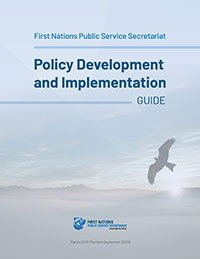- Defining policy and how it is used
- Distinctions between policy and procedures
- Understanding policy from Leaders’ and Administrators’ perspectives
- Difference between law and policy
- Rationale for developing policy and the key triggers
- Looking at the assumptions about policy
- Key principles of policy making
- Understanding the key considerations for policy development
- Community policy scenario – interactive questions
Module 1: Defining Policy
Module 1 provides a general orientation on what policy is and how policy is used. Specifically, Module 1 provides information to build understanding on the development and use of policy. It creates a foundation for looking at the ways and means that First Nations can develop policies to support the vision and goals of their communities. The following topics are covered in Module 1:
- Defining policy and how it is used
- Distinctions between policy and procedures
- Understanding policy from Leaders’ and Administrators’ perspectives
- Difference between law and policy
- Rationale for developing policy and the key triggers
- Looking at the assumptions about policy
- Key principles of policy making
- Understanding the key considerations for policy development
Defining policy and how it is used
‘Policy‘, as defined by the Merriam Webster Dictionary, is “a definite course or method of action selected from among alternatives and in light of given conditions to guide and determine present and future decisions”.1
Policy refers to the actions governments or organizations take to address issues. Policy sets out what a First Nation intends to do, or not do, and why the First Nation has taken that decision. Policy can be guidelines, rules, regulations, laws, principles or directions. When speaking about policy in a government context, policy refers to plans that influence decision making. Policy is also a tool that supports communities to achieve their goals and brings clarity to how First Nations operate to the benefit of their community members. Policy can support governance, operations, programs or strategies.
 Policies in the First Nation Case Study impact decision making around governance, finance, information management and personnel. Policies in a First Nation community can also impact decision making around elections, housing, education, cultural heritage, referrals / consultation and health.
Policies in the First Nation Case Study impact decision making around governance, finance, information management and personnel. Policies in a First Nation community can also impact decision making around elections, housing, education, cultural heritage, referrals / consultation and health.
There are many types of policies, but the three main ones discussed in this Guide are:
- Strategic policy: Guides institution-wide direction (e.g. a First Nation’s platform)
- Program policy: Guides a particular sector (e.g. the economy) or an issue (e.g. childcare)
- Operational policy: Describes how organizations are managed internally to achieve their goals (e.g. human resource policies)
Effective policy development and implementation create better decision making within First Nations. Policy development represents one function that governments can undertake to address critical issues and challenges within the First Nation. It is important that First Nations are guided by thoughtful, honest policy advice based on proper analysis, sound knowledge of administrative practices and sensible precedents.
Policies can do the following:
- Guide community actions to achieve desired outcomes
- Guide and create a framework for implementing First Nation decisions
Policy issues can be brought to the attention of relevant decision makers (e.g. Leaders or appointed Committee members) by future leaders in the electoral process, and other times they can be raised between elections by communities of interest, individual members of the public, special interest groups and the media. Policies are proposed for several reasons:
- Community interests and needs
- Political context, such as electoral commitments to health and education priorities
- Governance context, such as intergovernmental relationships and challenges
- Other considerations, such as demographics, natural disasters and economic conditions
A community of interest may be formed when several First Nations have common goals, such as watershed governance.
An example of a special interest group is a Stockman’s Committee that is made up owners of stock (in UNB’s case, horse or cattle).
First Nation Case Study – Upper Nicola Band
 UNB was required to develop and adopt policies in four key areas
to implement the FAL 2018:
UNB was required to develop and adopt policies in four key areas
to implement the FAL 2018:
- Governance
- Finance
- Information Management
- Personnel
These policies:
- Give directions respecting any matter relating to financial administration
- Address the acquisition, management and safeguarding of First Nation assets
- Identify effective internal financial administration controls
- Provide employees of the UNB with definitions of the treatment, rights, obligations and relations of people in an organization
Collectively, the policies assist UNB in reaching its goal of reaching financial transparency and accountability for its members.
Distinctions between policy and procedures
Procedures are the specific methods employed to translate policies into day-to-day operations of the organization. Procedures describe the detailed actions and activities required to implement policies.
Procedures usually include the positions within the First Nation responsible for implementing the actions, any time requirements and any consequences or repercussions for actions not being performed.
First Nation and community activities take place within the boundaries set by these policies and procedures. Together, policies and procedures ensure that a point of view held by the First Nation is translated into steps that result in an outcome compatible with that view.
First Nation Case Study – Upper Nicola Band
Once UNB had approved the four policies, the Senior Management Team put in place an Operational Manual. The Operational Manual is a compilation of the procedures and forms that assist all employees with implementation of the four policies and standardize administrative functions. The Operational Manual includes:
- Human Resources procedures and forms
- Payroll and Finance procedures and forms
- Office procedures, guidelines and forms
- Purchasing and contracting procedures, guidelines and forms
Understanding policy from Leaders’ and Administrators’ perspectives
Senior Administrators assist Leaders in developing policy to achieve community goals and to provide clarity regarding First Nations operations as well as to identify benefits for their community members.
The First Nations Fiscal Management Act (FNFMA) provides First Nation governments with authority over financial management, property taxation and local revenues, and/or financing for infrastructure and economic development.2 After a First Nation is scheduled to the FNFMA, it may begin working with any/all of the First Nations institutions established under the Act (the First Nation Financial Management Board (FNFMB), the First Nation Tax Authority (FNTC) and the First Nation Finance Authority (FNFA)) and determine the laws and policies it needs to develop to support its goals that also meet the requirements of each institution.
After a policy is approved, it is the Administrators’ responsibility to implement the policy. Once Administrators begin to implement a policy and they recognize insufficiencies with a specific policy, it is the responsibility of the Administrators to bring recommended policy amendments forward to the Leaders for amendment.
Difference between law and policy
As defined by the Merriam Webster Dictionary, a ‘law‘ is “a binding custom or practice of a community; a rule of conduct or action prescribed or formally recognized as binding or enforced by a controlling authority.”3
Laws are standards of the First Nation that members and stakeholders are required to follow to ensure sustainability of a resource and/or to benefit the community as a whole.
The FMB defines ‘financial administration law‘ (FAL) as “a set of governance and finance practices that helps Councils and staff make informed decisions and run their First Nation well. A First Nation that lives by its FAL commits to good governance and finance practices over the long-term.”4
First Nations can pass other laws at their discretion. As of January 2020, under Bill C92, An Act respecting First Nations, Inuit and Métis children, youth and families,5 Parliament affirms the right to self-determination of Indigenous peoples, including the inherent right of self-government, which includes jurisdiction in relation to child and family services. This is relevant to this Guide as once First Nations pass a community and/or a First Nation law, they need to have policies in place to assist with implementation of these laws.
Once First Nations pass a community and/or a First Nation law, they need to have policies in place to assist with implementation of these laws.
First Nation Case Study – Upper Nicola Band
UNB requested that they be added to the schedule of the First Nations Fiscal Management Act by submitting a Band Council Resolution to the Minister of Indian Affairs, now known as the Minister of Crown-Indigenous Relations. Since 2006, approximately 300 First Nations are scheduled to (or are participating in) the First Nations Fiscal Management Act6 and more are asking to be added on a regular basis.7
Rationale for developing policy and the key triggers
 Policy is developed for many different reasons. It serves to clarify:
Policy is developed for many different reasons. It serves to clarify:
- What is to be done
- Who is to do it
- How it is to be done
- For whom it is to be done or who it is intended to help
Policy is intended to:
- Address a critical public, community or business need
- Support effective public administration and governance
- Help implement a First Nation’s vision, mission and goals
- Support gender equality and fair approaches
- Support a First Nation’s economy and economic development
- Focus on addressing the socio-economic objectives of the community, including program and service delivery
- Help create sustainable institutions and infrastructure
There are often trigger points for communities that lead to policy discussions and development. Some common triggers include the following:
- The pursuit of self-government or a Treaty
- The pursuit of a governance initiative (e.g. a land code, an education program or a child and family safety initiative)
- The creation and implementation of laws and/or regulations
- A new opportunity (e.g. business development or community engagement)
- Implementation of a community plan
- A community crisis (e.g. a youth suicide or a health or potable water emergency)
- A specific commitment to a community interest or objective
- A need to implement a new program or a new way to manage operations
First Nation Case Study – Upper Nicola Band
UNB identified the following triggers for policy development:
- The goal of financial transparency and accountability, as a result of community demands
- The need to find a better way to manage the financial affairs of the community
- The fact that the community’s management of its finances was threatened and nearing default8
Looking at the assumptions about policy
There are many assumptions about the development and implementation of policy based on a variety of different perspectives. Some more common assumptions include that it:
- Is a set of rules
- Is reactive and random
- Limits innovation and creativity
- Is intended to create consistent action
- Defines responses to a challenge
- Prescribes action
- Can create unintended consequences
- Can be long and complex
Often times, there may be resistance to introducing policy in large part due to the above assumptions. These assumptions should be considered when sharing information with communities about the purpose and rationale for a policy.

Key principles of policy making
First Nations can determine the principles that they support in developing effective policy. These principles tend to be those supported by a First Nation in planning and daily activities. The following is a list of principles that could assist in creating a helpful framework for developing policy.
 Transparency
Transparency
Being clear about what issue, concern or opportunity is being addressed Clarity
Clarity
Being precise about the specific objective of a policy Openness
Openness
Communicating openly about the intent to pursue or explore a policy Fairness
Fairness
Addressing a critical issue but does not result in unfair treatment Collaboration
Collaboration
Engaging with the community, partners and others who have an interest in the issue, concern or opportunity Integrity
Integrity
Reflecting identified interests Accountability
Accountability
Communicating the policy process and following the process Commitment
Commitment
Supporting implementation of the policy and undertaking reviews to help ensure the policy is meeting its intended objectives
First Nation Case Study – Upper Nicola Band
For UNB, the key principles of policy making are transparency, accountability and commitment. UNB agrees that the three principles are important and should be considered in policy development.
Understanding the key considerations for policy development
In order to create policy that addresses the key goals and objectives of a First Nation, there are several issues and factors to consider. When starting to consider development of a policy, it is important to understand the issues and factors, including financial, environmental and/or political, that may create challenges for developing the policy. The following is a sample list of the critical factors:
- Ability to identify specific issue(s) to be addressed
- Ability to achieve agreement among Leaders on the need for the policy and the policy issue
- Access to leaders or champions in developing the policy
- Sufficient public and community engagement on policy development (that leads to support)
- Capacity to develop policy
- Access to the necessary expertise
- Ability to obtain adequate evidence
- Ability to communicate the purpose of the policy
- Resources to support the policy development and its implementation
First Nation Case Study – Upper Nicola Band
UNB’s goal to seek FMS Certification was an incremental learning process in which the Senior Administrators were learning about the FAL 2018 and accompanying required policies. As part of this process, they needed to transfer newly learned knowledge to the Leaders, as well as to other Administrators who were expected to implement the policies. Once UNB had the workplan in place to seek FMS Certification, Leaders and Administrators had to ensure that they educated and informed the membership. Community engagement took place at General Band Meetings, Annual General Meetings and through the community newsletter and the annual report. UNB did not always have the capacity to complete all plans and policies and were able to work with the FMB to develop policies. The FMB provided policy templates that were the starting point for policy development (more on this in Module 2).
Community policy scenario – interactive questions
 Several key concepts are reviewed in Module 1,
such as the purpose of policy, and different rationales, events or factors that trigger policy development. To assist you with learning about the concepts presented, think about a policy needed, or a time when you developed policy, and provide responses to the questions below.
Several key concepts are reviewed in Module 1,
such as the purpose of policy, and different rationales, events or factors that trigger policy development. To assist you with learning about the concepts presented, think about a policy needed, or a time when you developed policy, and provide responses to the questions below.
Download the interactive questions (Microsoft Word)
| Policy Example | |
|---|---|
Topic / Subject: |
Type of Policy: |
What are the interests of the First Nation in this policy area?
|
|
What is the policy subject or issue?
|
|
Describe the trigger(s) for the policy issue. |
|
How were these policy triggers identified? |
|
What are the key principles guiding this policy development process? |
|
How can these principles be addressed in the policy? |
|
Footnotes
[1] Merriam Webster Dictionary. “Policy”. Retrieved from: www.merriam-webster.com/dictionary/policy
[2] INAC. “First Nations Fiscal Management”. Retrieved from: www.aadnc-aandc.gc.ca/eng/1393512745390/1393512934976
[3] Merriam Webster Dictionary. “Law”. Retrieved from: www.merriam-webster.com/dictionary/law
[4] FMB. “Financial Administration Law”. Retrieved from: fnfmb.com/en/services/certify-first-nations/financial-administration-law-fal
[5] Justice Laws Website. “An Act respecting First Nations, Inuit and Métis children, youth and families”. Retrieved from: laws.justice.gc.ca/eng/acts/F-11.73/page-1.html#h-1150567
[6] INAC. “First Nations Fiscal Management”. Retrieved from: www.aadnc-aandc.gc.ca/eng/1393512745390/1498849002682
[7] INAC. “First Nations Fiscal Management”. Retrieved from: www.aadnc-aandc.gc.ca/eng/1393512745390/1498849002682
[8] INAC. “Backgrounder – Default Prevention and Management Policy”. Retrieved from: www.aadnc-aandc.gc.ca/eng/1322681440476/1322681618248
